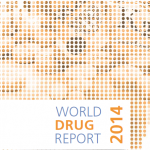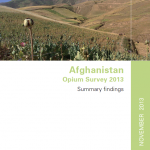See also: Even More Photos of US/NATO Troops Patrolling Opium Poppy Fields in Afghanistan More Photos of US/NATO Troops Patrolling Opium Poppy Fields in Afghanistan US/NATO Troops Patrolling Opium Poppy Fields in Afghanistan
31 search results for "poppy"
Afghanistan, United Nations
UNODC Afghan Poppy Eradication Report May 2012
The Ministry of Counter Narcotics (MCN) and the United Nations Office on Drugs and Crime (UNODC) have joint responsibility of monitoring and verifying opium poppy eradication activities led by the Governors. Governor-led eradication activities are envisaged in all poppy cultivating provinces. Two MCN/UNODC reporters are deputed in MCN for collection of daily reports from the field verifiers and two MCN staffs are assigned for preparing weekly report under UNODC supervision as a part of capacity building activity.
Headline
Even More Photos of US/NATO Troops Patrolling Opium Poppy Fields in Afghanistan
See also: More Photos of US/NATO Troops Patrolling Opium Poppy Fields in Afghanistan US/NATO Troops Patrolling Opium Poppy Fields in Afghanistan
Headline
More Photos of US/NATO Troops Patrolling Opium Poppy Fields in Afghanistan
The following photos were released by the DoD and NATO over the last month. See also: US/NATO Troops Patrolling Opium Poppy Fields in Afghanistan
Afghanistan, United States
US/NATO Troops Patrolling Opium Poppy Fields in Afghanistan
These photos have been released by the Department of Defense and ISAF over the last few years. Some of the photos discuss instances of troops helping with the destruction of poppy fields. Many of the photos do not mention anything…
Drug Enforcement Administration
DEA Drug Slang Code Words
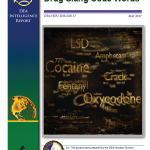
This Drug Enforcement Administration (DEA) Intelligence Report contains information from a variety of law enforcement and open sources. It is designed as a ready reference for law enforcement personnel who are confronted by many of the hundreds of slang terms used to identify a wide variety of controlled substances, designer drugs, and synthetic compounds. Every effort has been made to ensure the accuracy and completeness of the information presented. However, due to the dynamics of the ever-changing drug scene, subsequent additions, deletions, and corrections are inevitable. Further addendums to this report will attempt to capture changed terminology, to the extent possible. This compendium of drug slang terms has been alphabetically ordered, and identifies drugs and drug categories in English and foreign language derivations.
Afghanistan, United Nations
UNODC Afghanistan Opium Survey 2015
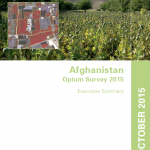
The report presents the key findings of the Afghanistan Opium Survey 2015. The full report on cultivation and production will be published in November and a separate report with a socioeconomic analysis will be presented early 2016. The survey is implemented annually by MCN in collaboration with the UNODC. The survey team collects and analyses information on the location and extent of opium cultivation, potential opium production and the socio-economic situation in rural areas. Since 2005, MCN and UNODC have also been involved in the verification of opium eradication conducted by provincial governors and poppy-eradication forces. The information is essential for planning, implementing and monitoring the impact of measures required for tackling a problem that has serious implications for Afghanistan and the international community.
New Jersey
(U//FOUO) New Jersey Fusion Center Drug Monitoring Initiative (DMI) Drug Identification Guide
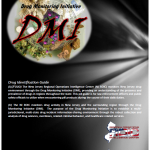
The New Jersey Regional Operations Intelligence Center (NJ ROIC) monitors New Jersey drug environment through the Drug Monitoring Initiative (DMI), providing an understanding of the presence and prevalence of drugs in regions throughout the state. This pill guide is for law enforcement officers and public safety officials to utilize when encountering pill products during the course of their daily duties.
Afghanistan, United Nations
UNODC Afghanistan Opium Survey 2014
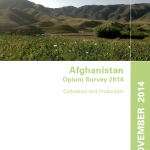
The Afghanistan Opium Survey is implemented annually by the Ministry of Counter Narcotics (MCN) of Afghanistan in collaboration with the United Nations Office on Drugs and Crime (UNODC). The survey team collects and analyses information on the location and extent of opium cultivation, potential opium production and the socio-economic situation in rural areas. Since 2005, MCN and UNODC have also been involved in the verification of opium eradication conducted by provincial governors and poppy-eradication forces. The results provide a detailed picture of the outcome of the current year’s opium season and, together with data from previous years, enable the identification of medium- and long-term trends in the evolution of the illicit drug problem. This information is essential for planning, implementing and monitoring the impact of measures required for tackling a problem that has serious implications for Afghanistan and the international community.
United Nations
UNODC Study: Impacts of Drug Use on Users and Their Families in Afghanistan
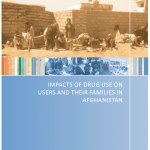
Afghanistan is the world’s largest producer and cultivator of opium poppies; it produces almost three quarters of the world’s illicit opium. While a significant amount of the opium produced in Afghanistan is trafficked out of the country, in 2009 it was estimated that almost 10 per cent of Afghans aged between 15 and 64 were drug users.
United Nations
UNODC World Drug Report 2014
United Nations
UNODC Southeast Asia Opium Survey 2013
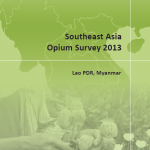
A total area of over 62,000 hectare of opium poppy cultivation took place in Lao People’s Democratic Republic (Lao PDR), Myanmar and Thailand in 2013. In order to assess the scope of opium poppy cultivation and opium production in the region, UNODC has been conducting opium surveys in cooperation with the Government of Lao PDR since 1992 and the Government of the Republic of the Union of Myanmar (GOUM) since 2002, while Thailand established its own monitoring system. This report contains the results of the 2013 UNODC-supported opium poppy cultivation surveys in Lao PDR and Myanmar. In addition, the results from the opium poppy surveys implemented by the Government of Thailand are presented in this regional overview.
Afghanistan, United Nations
UNODC Afghanistan Opium Survey 2013
Headline
Afghanistan Night Operations Photos
Afghanistan, United Nations
UNODC Afghanistan Opium Survey 2012
Afghanistan cultivates, produces and process narcotics that are a threat to the region and worldwide. However, the international community also needs to understand that Afghanistan itself is a victim of this phenomenon. The existence of hundreds of thousands of problem drug users, as well as decades of civil war, terrorism and instability are all related to the existence of narcotics in the country. According to the findings of this survey, the total area under cultivation was estimated at 154,000 hectares, an 18 per cent increase from the previous year. Comparisons of the gross and net values with Afghan’s licit GDP for 2012 also serve to highlight the opium economy’s impact on the country. In 2012, net opium exports were worth some 10 per cent of licit GDP, while the farmgate value of the opium needed to produce those exports alone was equivalent to 4 per cent of licit GDP. On the basis of shared responsibility and the special session of the United Nation’s General assembly in 1998, the international community needs to take a balanced approach by addressing both the supply and the demand side equally. In addition, more attention needs to be paid to reduce demand and the smuggling of precursors as well as provide further support to the Government of Afghanistan.
Afghanistan, United Nations
UNODC Afghanistan Opium Risk Assessment 2013
The findings of the 2013 Opium Risk Assessment in the Southern, Eastern, Western and Central regions points to a worrying situation. The assessment suggests that poppy cultivation is not only expected to expand in areas where it already existed in 2012, e.g. in the area north of the Boghra canal in Hilmand province or in Bawka district in Farah province but also in new areas or in areas where poppy cultivation was stopped. In eastern Afghanistan, in Nangarhar province, farmers resumed cultivation even in districts where poppy has not been present for the last four years. In the Northern and Northeastern region, the provinces of Balkh and Takhar which were poppy-free for many years are at risk of resuming poppy cultivation.
United Nations
UNODC Afghanistan Opium Survey November 2012
Despite the eradication of opium poppy by Governor-led Eradication (GLE) having increased by 154% in comparison to its 2011 level (9,672 hectares eradicated in 2012), the total area under opium poppy cultivation in Afghanistan was estimated at 154,000 hectares (125,000 – 189,000) in 2012. While that represents a 18% increase in cultivation, potential opium production was estimated at 3,700 tons (2,800 – 4,200 tons) in 2012, a 36% decrease from the previous year. This was due to a decrease in opium yield caused by a combination of a disease of the opium poppy and adverse weather conditions, particularly in the Eastern, Western and Southern regions of the country.
Afghanistan, North Atlantic Treaty Organization
NATO Civil-Military Fusion Centre Counter-Narcotics in Afghanistan Report August 2012
Despite the continuous counter-narcotics efforts of the international community and the Afghan government throughout the past decade, Agence France-Presse wrote in April 2012 that Afghanistan continues to be a major contributor to the global drug supply. Approximately 90% of the world’s opium, most of which is processed into heroin, originates in Afghan fields. While potential opium production in Afghanistan peaked in 2007, poppy cultivation has recently risen. For instance, the United Nations Office on Drugs and Crime (UNODC) marked a 61% increase in the potential opium production between 2010 and 2011. A separate UNODC report from 2010 states that drugs and bribes are equivalent to approximately a quarter of Afghanistan’s gross domestic product (GDP).
Afghanistan, U.S. Army
(U//FOUO) U.S. Army Security Force Assistance: Shaping and Mentoring the Afghan Police
Afghanistan presents a unique challenge to U.S. Army forces in the geographical, cultural, economic, political, and security dimensions. Providing protection and security to a unique and diverse tribal population is an essential aspect of our counterinsurgency strategy. The proficiency, integrity, and loyalty of Afghan police forces are essential to accomplishing a secure environment and to sustaining success. The following articles cover a range of issues related to SFA and the training of Afghan national police and border police with the specific intent of establishing best practices and lessons learned. The collection should not be considered all-inclusive. This is an effort to capture relevant articles published in recent professional journals or maintained by the Center for Army Lessons Learned (CALL) and other joint archives to inform Soldiers about relevant observations, insights, and lessons and to provide a historical document for future reference.
U.S. Marine Corps
(U//FOUO) Center for Naval Analyses Study: The War in Southern Afghanistan 2001-2008
This study examines the history of the fighting in southern and western Afghanistan since 2001. The Marine Corps Intelligence Activity sponsored the study. Its purpose is to give Marines a basic understanding of what has happened in southern and western Afghanistan. Most Marines will operate in that area and we hope a historical reference source will be useful. If the study has any single argument it is that government misrule has been a driving factor behind the continuing violence in southern and western Afghanistan. The Afghan government favored warlords, handicapped competent governors, took part in the poppy trade, and allowed the police to abuse the people. Scarcity of security forces and collateral damage from Coalition operations did not help either. Yet above all, we find it unlikely that the instability in southern and western Afghanistan today could have been averted without addressing government misrule.
Afghanistan, U.S. Army
(U//FOUO) Afghanistan Human Terrain Team AF-24 Quarterly Report Summer 2011
Local governance in rural Afghanistan is not simple. Older customary local assemblies operate alongside GIRoA officials, Community Development Councils (CDC’s), and insurgent groups. Although we speak of insurgent governments as “shadow governments,” they rarely exist in the shadows for those over whom they wield power. In villages where insurgents continue to exercise control, the insurgents and not GIRoA perform traditional governmental functions; they levy taxes, resolve disputes (they are, in many villages the only law in town), and maintain local defense forces. Western Powers have invested their hope and their treasure in inventing a new form of local control: Community District Councils that come out of the National Solidarity Program (NSP). Managed by the Ministry of Rural Rehabilitation and Development (MRRD) with funds from NGO’s and from the World Bank, these organizations set priorities for the expenditure of donor money and oversee contracts. Although they offer an alternative to the indiscriminate funding of the past that encouraged favoritism and corruption, these organizations have little authority except when it comes to the stewardship of outside money. As those development funds begin to dry up, will CDC’s vanish? Can they be further empowered?
United Nations
UNODC Afghanistan Opium Survey October 2011
The total area under opium poppy cultivation in Afghanistan in 2011 was estimated at 131,000 hectares (ha), a 7% increase compared to 2010. 95% of total cultivation took place in nine provinces in the Southern and Western regions, which include the most insecure provinces in the country. This confirms the link between insecurity and opium cultivation observed since 2007. The number of poppy-free provinces decreased from 20 in 2010 to 17 in 2011 as Baghlan and Faryab provinces in the Northern region and Kapisa province in the Eastern region lost their poppy-free status. Potential opium production in 2011 was estimated at 5,800 mt, a 61% increase compared to 2010, when opium yields were much reduced due to plant diseases.
United Nations
UNODC World Drug Report 2011
Globally, UNODC estimates that, in 2009, between 149 and 272 million people, or 3.3% to 6.1% of the population aged 15-64, used illicit substances at least once in the previous year. About half that number are estimated to have been current drug users, that is, having used illicit drugs at least once during the past month prior to the date of assessment. While the total number of illicit drug users has increased since the late 1990s, the prevalence rates have remained largely stable, as has the number of problem drug users, which is estimated at between 15 and 39 million.
Headline
More Afghan Children
See also: Afghan Children
United Nations
UNODC Afghanistan Opium Survey Winter Assessment 2011
The result of this assessment indicates that the current high price of opium did not produce an increase in opium cultivation in the highest cultivating provinces of Hilmand and Kandahar. In these two provinces the cultivation is expected to decrease in 2011. The reasons for this development were multiple and differed from area to area. In parts of Hilmand and Kandahar, farmers reported the persistence of cold and dry climate conditions which led to crop failure as the poppy would not germinate. There also been a changing political environment in Hilmand with the Governor taking initiatives to convince elders and farmers to reduce the amount of poppy planted. This was not systematically captured by the survey, but it may have played a role as well. In both provinces, military operations were conducted by Afghan and international forces around the time of poppy planting in main poppy cultivating areas. Although these operations were not directed against poppy farmers, the coincidence of troupes being present at planting time may also have discouraged farmers from planting poppy.

